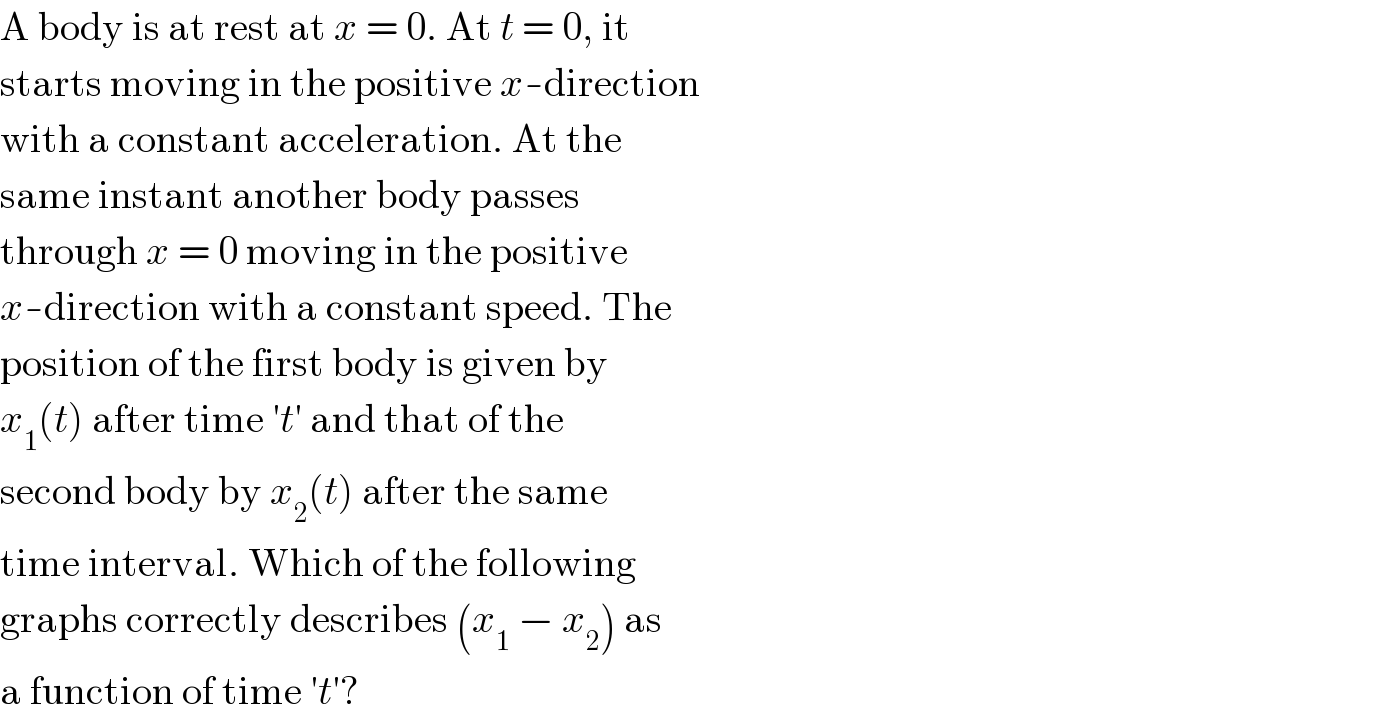
Question Number 16645 by Tinkutara last updated on 24/Jun/17

$$\mathrm{A}\:\mathrm{body}\:\mathrm{is}\:\mathrm{at}\:\mathrm{rest}\:\mathrm{at}\:{x}\:=\:\mathrm{0}.\:\mathrm{At}\:{t}\:=\:\mathrm{0},\:\mathrm{it} \\ $$$$\mathrm{starts}\:\mathrm{moving}\:\mathrm{in}\:\mathrm{the}\:\mathrm{positive}\:{x}-\mathrm{direction} \\ $$$$\mathrm{with}\:\mathrm{a}\:\mathrm{constant}\:\mathrm{acceleration}.\:\mathrm{At}\:\mathrm{the} \\ $$$$\mathrm{same}\:\mathrm{instant}\:\mathrm{another}\:\mathrm{body}\:\mathrm{passes} \\ $$$$\mathrm{through}\:{x}\:=\:\mathrm{0}\:\mathrm{moving}\:\mathrm{in}\:\mathrm{the}\:\mathrm{positive} \\ $$$${x}-\mathrm{direction}\:\mathrm{with}\:\mathrm{a}\:\mathrm{constant}\:\mathrm{speed}.\:\mathrm{The} \\ $$$$\mathrm{position}\:\mathrm{of}\:\mathrm{the}\:\mathrm{first}\:\mathrm{body}\:\mathrm{is}\:\mathrm{given}\:\mathrm{by} \\ $$$${x}_{\mathrm{1}} \left({t}\right)\:\mathrm{after}\:\mathrm{time}\:'{t}'\:\mathrm{and}\:\mathrm{that}\:\mathrm{of}\:\mathrm{the} \\ $$$$\mathrm{second}\:\mathrm{body}\:\mathrm{by}\:{x}_{\mathrm{2}} \left({t}\right)\:\mathrm{after}\:\mathrm{the}\:\mathrm{same} \\ $$$$\mathrm{time}\:\mathrm{interval}.\:\mathrm{Which}\:\mathrm{of}\:\mathrm{the}\:\mathrm{following} \\ $$$$\mathrm{graphs}\:\mathrm{correctly}\:\mathrm{describes}\:\left({x}_{\mathrm{1}} \:−\:{x}_{\mathrm{2}} \right)\:\mathrm{as} \\ $$$$\mathrm{a}\:\mathrm{function}\:\mathrm{of}\:\mathrm{time}\:'{t}'? \\ $$
Commented by Tinkutara last updated on 24/Jun/17

Answered by ajfour last updated on 24/Jun/17
![only a little time after t=0 x_2 will be greater than x_1 since the first body will have gained only a little velocity while the second body had an initial velocity of you, that is, if time has not progressed by much x_1 −x_2 < 0 .And after sufficient time first body (because it is accelerated) continues gaining velocity, surpases velocity u and then overtakes the second (x_1 =x_2 ) and thereafter their separation goes increasing[ (x_1 −x_2 ) increases]. such is represented only in (2) .](Q16652.png)
$$\mathrm{only}\:\mathrm{a}\:\mathrm{little}\:\mathrm{time}\:\mathrm{after}\:\mathrm{t}=\mathrm{0}\: \\ $$$$\mathrm{x}_{\mathrm{2}} \:\mathrm{will}\:\mathrm{be}\:\mathrm{greater}\:\mathrm{than}\:\mathrm{x}_{\mathrm{1}} \:\mathrm{since} \\ $$$$\mathrm{the}\:\mathrm{first}\:\mathrm{body}\:\mathrm{will}\:\mathrm{have}\:\mathrm{gained} \\ $$$$\mathrm{only}\:\mathrm{a}\:\mathrm{little}\:\mathrm{velocity}\:\mathrm{while}\:\mathrm{the} \\ $$$$\mathrm{second}\:\mathrm{body}\:\mathrm{had}\:\mathrm{an}\:\mathrm{initial} \\ $$$$\mathrm{velocity}\:\mathrm{of}\:\mathrm{you},\:\mathrm{that}\:\mathrm{is},\:\mathrm{if}\:\mathrm{time} \\ $$$$\mathrm{has}\:\mathrm{not}\:\mathrm{progressed}\:\mathrm{by}\:\mathrm{much} \\ $$$$\:\mathrm{x}_{\mathrm{1}} −\mathrm{x}_{\mathrm{2}} <\:\mathrm{0}\:.\mathrm{And}\:\mathrm{after}\:\mathrm{sufficient} \\ $$$$\mathrm{time}\:\mathrm{first}\:\mathrm{body}\:\left(\mathrm{because}\:\mathrm{it}\:\mathrm{is}\:\mathrm{accelerated}\right) \\ $$$$\mathrm{continues}\:\mathrm{gaining}\:\mathrm{velocity},\:\mathrm{surpases} \\ $$$$\mathrm{velocity}\:\mathrm{u}\:\mathrm{and}\:\mathrm{then}\:\mathrm{overtakes}\:\mathrm{the} \\ $$$$\mathrm{second}\:\left(\mathrm{x}_{\mathrm{1}} =\mathrm{x}_{\mathrm{2}} \right)\:\mathrm{and}\:\mathrm{thereafter}\:\mathrm{their}\:\mathrm{separation} \\ $$$$\mathrm{goes}\:\mathrm{increasing}\left[\:\left(\mathrm{x}_{\mathrm{1}} −\mathrm{x}_{\mathrm{2}} \:\right)\:\mathrm{increases}\right]. \\ $$$$\mathrm{such}\:\mathrm{is}\:\mathrm{represented}\:\mathrm{only}\:\mathrm{in}\:\left(\mathrm{2}\right)\:. \\ $$
Commented by Tinkutara last updated on 24/Jun/17

$$\mathrm{Thanks}\:\mathrm{Sir}! \\ $$
